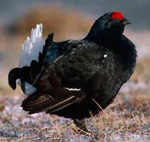
 |
|||||
Northumberland April 28th – May 3rd 2008 Holiday reportGuests attending Roger and Sue Fitzwater
Monday 28th April
Tuesday 29th April Encouraged by a cloudless sky, we drove north-east to Seahouses on the Northumberland coast and caught a boat across to Inner Farne, one of the islands owned and managed by the National Trust and home of tens of thousands of nesting seabirds. The first Puffins streamed past us on the boat ride out. The late spring had delayed seabird nesting and our arrival on Inner Farne was heralded by hundreds of Sandwich and Arctic terns loafing near the jetty in the prelude to their breeding. Once on the island, close ups of Eiders and Shags sitting on eggs excited us and the cacophony of Kittiwakes, Razorbills, Puffins and Guillemots courting and beginning their nest building and egg laying, was overwhelming. Our time on the island also included a brief chat with National Trust staff who were digesting some of the latest climate change impact forecasts for the Farnes. These wonderful seabirds might not have a bright future, as warming seas and changing climate space may alter their distribution around our coastline. Sobering news. After a long late lunch, we headed north to Lindesfarne National Nature Reserve. Redshank, Grey Heron, Ringed Plover and Wheatear were seen on the drive across the island causeway. Continuing stunning weather helped encourage us on a gentle stroll to Lindesfarne Castle where we ended our birding day watching the nesting antics of several pairs of Fulmars trying to squeeze into small openings in the Castle walls. Wednesday 30th April
Driving further south into the hills, we stopped several times to watch parties of Black Grouse, Lapwing with chicks, Redshank, Snipe, Curlew and Wheatear. Again, the weather made birding difficult. Thursday 1st May After yesterday’s inclement weather we tried another woodland birding morning, spending time at Wallington, a National Trust Estate in mid-Northumberland. The mature parkland makes for good wildlife watching and, despite some heavy showers, we were treated by wonderful views of Bullfinch, Blackcap, Garden Warbler, a confiding nest- building Wren, Nuthatch, Marsh Tit, Sparrowhawk and three fat red squirrels. After lunch we headed further north to a quiet moorland site that was home to one of England’s rarest breeding birds, the Hen Harrier. Protection of this site by a partnership of organisations has helped to give a rare opportunity to glimpse the breeding habits of this superb bird and, after a long walk, we were treated to the male harrier arriving with food and then passing it in mid-air to the female bird. This pair were still incubating eggs at this stage, but did manage to raise a healthy brood of chicks. Many thanks to the volunteer wardens who took the time to make us feel welcome and helped us see these birds. Friday 2nd May
Saturday May 3rd With only a morning of birding available, we headed south to the National Trust Gibside Estate in the Derwent Valley. Gibside is one the estates involved in helping to restore the natural range of the Red Kite in England and is a great place to see these birds. Looking out from the ruined orangery, several kites were seen lazily circling across the valley. On a short stroll along the river, a streak of electric blue gave us a brief glimpse of Kingfisher to end the holiday. Client comments from Roger and Sue“Nick’s manner was sympathetic and enthusiastic and he showed a lot of patience.” “Thank you for leading us to so many special Northumbrian places to glimpse the secret and public lives of birds – the wren building a nest, the eider on her eggs, the curlew’s preening, fabulous displays of lapwing, the magic of the Farnes, and much much more.”
Written by Nick Mason – holiday leader
 |
| ©2012 Real Birder | Home • Photos • Trip Reports• Links • Contact Us |